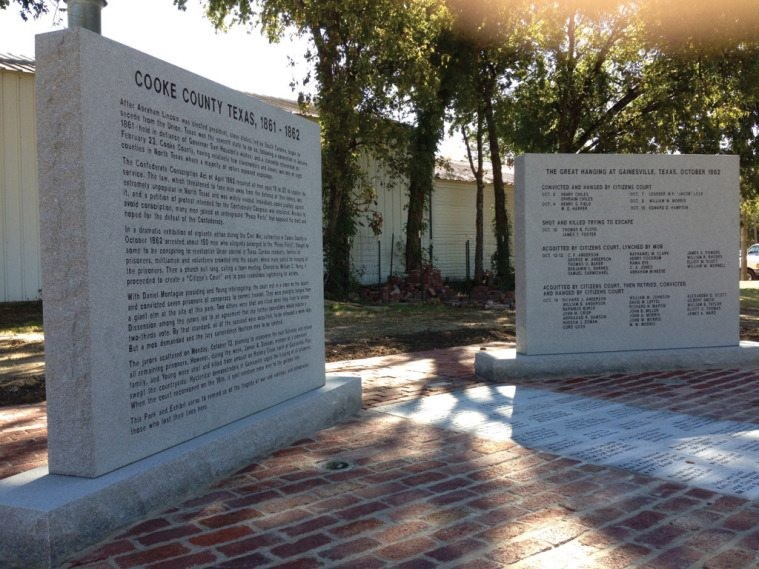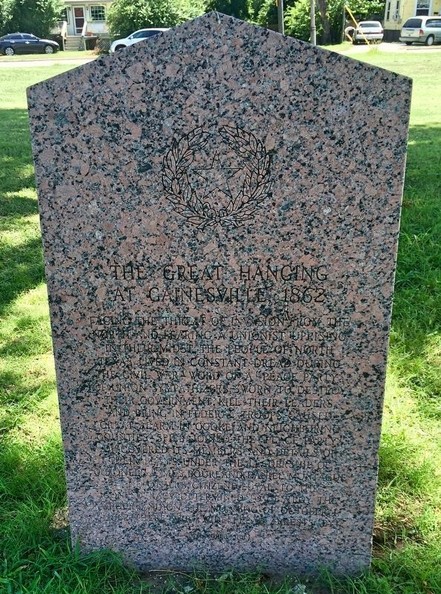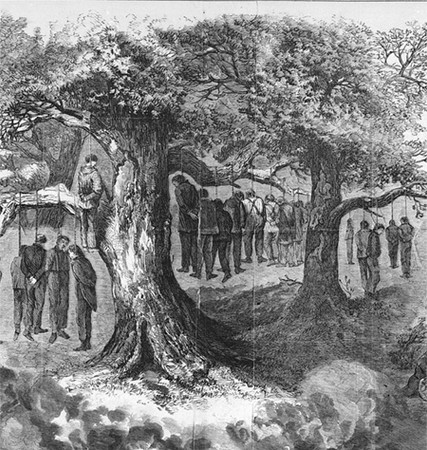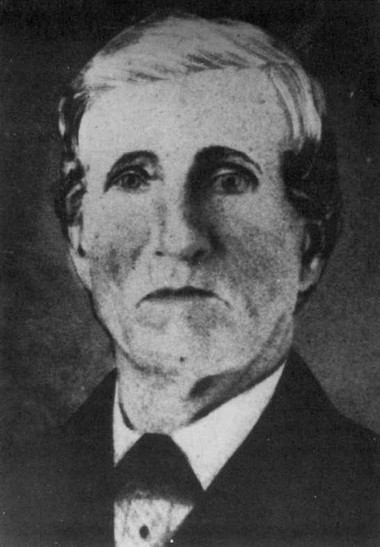Great Hanging at Gainesville
Introduction
Text-to-speech Audio
Images
The new markers for the Great Hanging

Great Hanging at Gainesville monument

Illustration of the Great Hanging, printed in Frank Leslie's Illustrated Weekly Newspaper; the victims were not actually hung all at once


Backstory and Context
Text-to-speech Audio
During the Civil War, North Texas roiled with intrigue, unrest, and violence. Although Texas seceded in early 1861 and joined the Confederacy, eight North Texas counties voted against secession, including Cooke County with the county seat of Gainesville. With relatively few slaveholders and a large population hailing from the Upper South and Midwest, Confederate support here proved weak. Further exacerbating tensions were the constant fear of Indian attacks by Comanches, Kiowas, and other Plains tribes. Although less-well-founded, rumors of slave uprisings and abolitionist raids from Kansas spread like wildfire.
In 1862, the Confederacy passed a conscription bill allowing the government to draft able-bodied men of fighting age into military service. Unpopular to begin with, the bill’s exemption of slaveowners from the draft angered many. In North Texas, a number of citizens banded together and formed a secret Peace Party (sometimes referred to as a Union League) response to conscription. Members were attracted to the League for a variety of reasons. Despite the group’s name, only a few were probably ardent Unionists; most simply opposed the draft and wished to stay out of Confederate service. Others wanted mutual protection in a time of uncertainty.
Word of the Union League leaked out, and reality was quickly subsumed by rumor. Some thought the League number 1,700 members (almost certainly false); other rumors claimed the group was seeking to overthrow local authorities. Many worried the group might be in touch with Northern abolitionists, enemy Indians, or the United States army.
In response to these rumors, Confederate Colonel James G. Bourland gathered local militia and arrested 70 local men on October 1, 1862, placing them in the Gainesville jail. Within days, the total arrested had doubled. Though many were arrested for dodging conscription, some were suspected of belonging to the "Peace Party," and claims of treason and conspiracy quickly emerged. Working with Colonel William C. Young, Colonel Bourland created a “citizen’s court” of 12 local jurors. Both the colonels were prominent slaveowners from Cooke County, and seven of the jurors were also slaveholders.
The jury initially declared seven men guilty (by simple majority vote) and sentenced them to death by hanging. But tensions in Gainesville ran high, and a mob (probably spurred on by Bourland) had formed in town to follow the proceedings. The mob was unsatisfied with the verdict. As jury member Thomas Barrett recalled, “a mob rose and sent two men into the jury room with word that if we did not give up twenty more to be hung, they would kill every man in the prison.”[4] The jury surrendered a list of twenty names, and fourteen more men were murdered. Unlike popular depictions of the sad affair, the men were not hung all at once, but by ones and twos. A few days after the initial hanging, Colonel James Young was killed by an unknown party. The officer’s death sparked another round of killings, and nineteen more men were hung. By the time the mob ended its reign, forty-two men had been killed, most from a big elm tree a half mile west of town.
The “Great Hanging at Gainesville,” as it became known, left dark scars on the community. Juror Barrett lamented that “everything seemed to quiet down, but there was fears that the friends of those men [killed] might seek revenge, consequently every man connected with this thing was on the lookout day and night.”[4] Families of the victims were outraged; several Confederate soldiers discovered their relatives had been killed by the mob. Private James Lemuel Clark learned that his father Nathaniel Clark had been hung by “the Bourland mob,” whom he considered “a cowardly gang” (Clark later defected to the Union army).[3] Local Texan authorities and press approved of the killings. Confederate President Jefferson Davis was embarrassed by the affair, which gave ammunition to Northern newspapers.
In the years since the event, Gainesville has struggled to reconcile the killings with its image as a small, patriotic, peaceful Texan town. As historian Richard McCaslin has noted, “They want their town to look good. You want to live in a town you’re proud of. That’s not a bad thing. Where does the Great Hanging fit into that? The town killed 42 people. It’s kind of a clunker.”[2] The town has downplayed the event, and Mayor Ray Nichols expressed disapproval over commemorating the 150th anniversary of the hangings.
Yet the Great Hanging has not gone entirely ignored. In 1964, the Texas Historical Commission placed a small pink granite marker on the site of the Great Hanging (one of many such markers at Texas-related Civil War sites). In 1993, the city acquired the land on which the killings occurred, and today it stands as a small city park. In 2013, the City Council approved a new granite memorial those killed at the Great Hanging.
Sources
1. Richard B. McCaslin, “Great Hanging At Gainesville.” Handbook of Texas Online. Web. Accessed December 9, 2020. https://www.tshaonline.org/handbook/entries/great-hanging-at-gainesville
2. Abby Rapoport. "How Do You Memorialize a Mob?" November 17, 2014. Texas Observer. Web. Accessed December 9, 2020. https://www.texasobserver.org/great-hanging-gainesville/
3. James Lemuel Clark. Civil War Recollections of James Lemuel Clark and the Great Hanging at Gainesville, Texas in October 1862. Plano, TX: Republic of Texas Press, 1997.
4. B.P. Gallaway, editor. Texas: The Dark Corner of the Confederacy, Contemporary Accounts of the Lone Star State in the Civil War. 3rd ed. Lincoln: University of Nebraska Press, 1994.
Pamela Henderson, Texas Observer: https://www.texasobserver.org/great-hanging-gainesville/
Mark Hilton, Historical Marker Database: https://www.hmdb.org/m.asp?m=97585
Handbook of Texas Online: https://www.tshaonline.org/handbook/entries/great-hanging-at-gainesville
